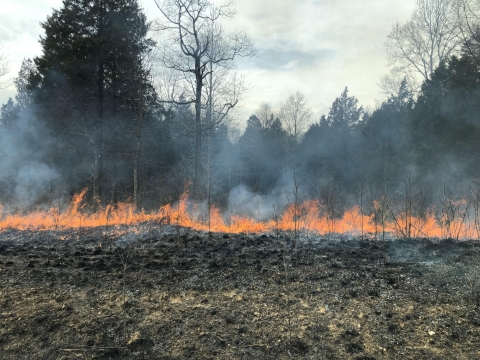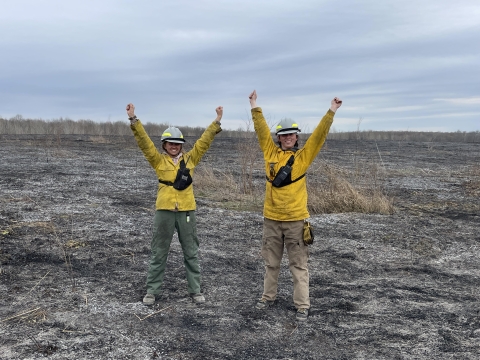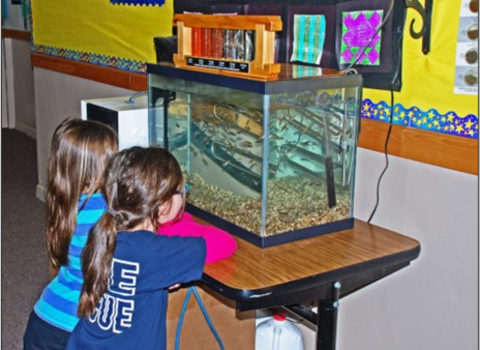Hello, my name is Audrey Basson and I'm a biological assistant volunteer intern and a newly certified wildland firefighter at Big Oaks National Wildlife Refuge in Madison, Indiana.
The fire crew at Big Oaks likes to joke that I have caught the fire bug - I'm afraid they are right. I was in awe after my first exposure to an evening wildfire two days after the completion of my firefighter training. Under the mentorship of senior firefighters, I lit a fireline, burning a perimeter to prevent the wildfire from spreading further. The glow of the orange flames against the dark blue sky is a visual that no picture could do justice.
A few months later, I was invited to Patoka River National Wildlife Refuge (Indiana) to complete my first prescribed burn prescribed burn
A prescribed burn is the controlled use of fire to restore wildlife habitat, reduce wildfire risk, or achieve other habitat management goals. We have been using prescribed burn techniques to improve species habitat since the 1930s.
Learn more about prescribed burn . This prescribed burn is truly when all the concepts in the fire training PowerPoints and videos came together. Without a working knowledge of fire, you may not realize how closely fire is linked to weather and how fire managers closely watch humidity levels, wind shifts, temperatures and overcast skies for proper burning conditions. At Patoka River, I saw firsthand, and most importantly understood, how the flames worked with or against the wind, and how fire managers created a burned black line around the burn unit to contain the flames within the desired area. In total, we burned 311 acres of grasslands to set back the encroachment of woody species and invasive plants, which are common at Patoka River, a former stripmine site, now being restored to native wildlife habitat.
The burn season continued at Big Oaks National Wildlife Refuge, and I learned the science behind the different types of vegetation, known by fire managers as fuel. When I didn’t understand fire as much as I do now, I thought the trees in the burn unit would burn down, but they don't! The prescribed fires are low intensity and don’t burn hot enough to consume anything except the leaf litter, the grasses and brush on the ground.
Big Oaks conducts prescribed burns for the same reasons as Patoka River: to combat invasive plant species and rejuvenate native grasslands. However, Big Oaks is not a former mining site like Patoka River, but a closed army proving ground where military weapons were tested for 50 years. In 2000, it became a National Wildlife Refuge. The refuge surrounds Jefferson Range, an Indiana Air National Guard training area.
A rare species that uses the grasslands here is the Henslow's sparrow, a state endangered species in Indiana. Big Oaks National Wildlife Refuge is home to one of the largest groups of nesting pairs (400) in the world and is designated a "Globally Important Bird Area." Prescribed fire is one way we maintain suitable nesting and foraging habitats for migratory birds.
As I was assigned various duties on a burn, I was able to experience a burn in all its stages, and how each person contributes to the success of the burn. The first firefighter on the line has the drip torch. They are followed by people driving a UTV with a small water tank, followed by the fire engine (the largest source of water). The beauty of a prescribed burn comes from this variety of the work and the relationship between fire and water. When I first started, I did not realize how crucial water was in a fire, not just to put fire out, but to prevent it from spreading as well. Very often, water is used before a fire is ever lit, wetting down structures, utility poles or signs to prevent them from catching fire or from being damaged. Water is also used to create wet lines on the ground. When fire reaches the wet grass, it puts itself out.
As the flames glide across the landscape, fire personnel follow in other UTVs and an engine, patrolling the line and ensuring embers don't escape. As the flames die down, the smoke lifts. Our job then is to look for hotspots, isolated pockets of smoldering fuel, within the burned area. This is called the mop-up stage, when we make sure the fire is extinguished.
During a fire, there is always something new to learn from the various firefighters you work with. On one occasion, I learned how to conserve water. I saw a standing dead tree, what we call a snag, partially burning and smoldering. I began to hose it down as I had done in the past. But as in all disciplines, there is a right tool for the right job. A senior firefighter handed me a Pulaski Pulaski
The Pulaski is a special hand tool used in wildland firefighting. The tool combines an axe and an adze in one head, similar to that of the cutter mattock, with a rigid handle of wood, plastic, or fiberglass. The Pulaski is a versatile tool for constructing firebreaks, as it can be used to both dig soil and chop wood.
Learn more about Pulaski (a specialized firefighting tool combining an axe and an adze in one head) and asked I break up the burning snag first. The Pulaski provided access to the hot spot by peeling away charred bark. While the part I was hosing down was hot, it was not the heat source, therefore the snag could have remained warm even with all the water I was hosing it down with.
Participating in all stages of the fire, burning a variety of different habitat types like grasslands and forests, learning how the tools and equipment are used, really makes all the training come together and shows how the planned application of fire can benefit wildlife and their habitats.
I went into the season thinking fire was going to be a one-time opportunity and only during my internship. However, I would love prescribed burns to be part of my future career in biology because I can directly see the impact to the wellbeing of the ecosystem and the species I wish to protect.





